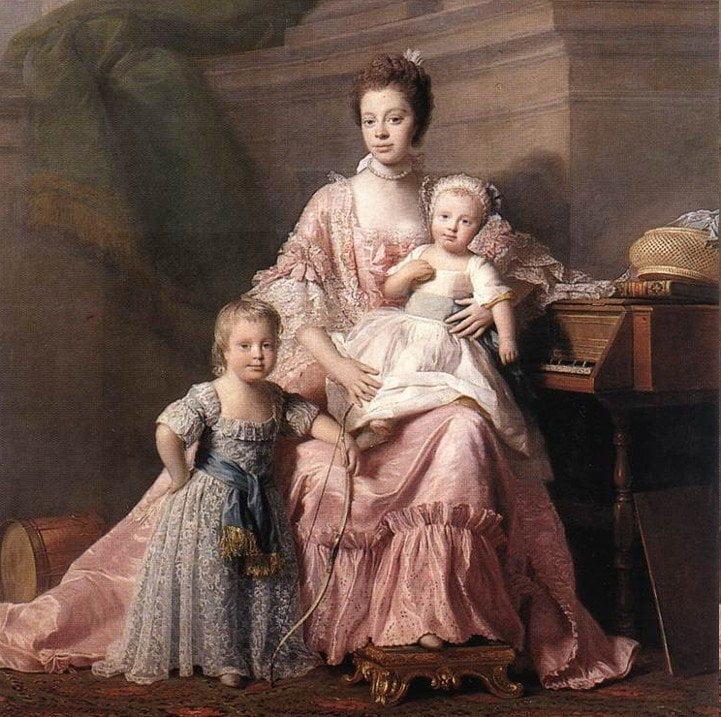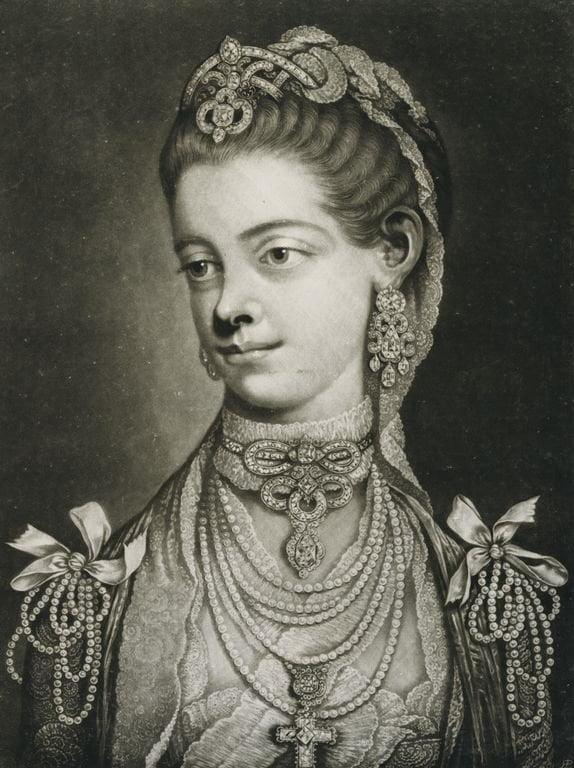England’s First “Black” Queen, Was Really Bi-racial, Sophie Charlotte Born 1744
by Kathy Grear 05/21/2018Intro
Contents
Princess Sophie Charlotte was born in 1744. She was the first bi-racial queen of England and the last queen of America. Portrait painters of the royal family were expected to play down or soften Queen Charlotte’s African features. She reigned during the American revolution and was our queen before we became independent. Charlotte NC is named after her.
Queen Charlotte, the actual first bi-racial member of royalty, also happens to be Prince Harry’s great-great-great-great-great-grandmother. That’s right. She’s Queen Victoria’s grandmother.
Many of the portraits portray her as very fair skinned, which was the fashion of the time. She most likely was highly powdered to appear more “fashionable”. 18th century skin lightening was lead based. Although this era was known as the Age of Enlightenment, most fashionable men and women poisoned themselves with red and white lead make-up and powder.
According to Mario de Valdes y Cocom, Charlotte had African ancestry, via descent from Margarita de Castro e Souza, a 15th-century Portuguese noblewoman, who traced her ancestry to King Afonso III of Portugal (1210–1279) and one of his mistresses, Madragana (c. 1230–?).

Portrait by Sir Allan Ramsay. 1769. of England’s First Black Queen
In a 2009 episode of the PBS TV series, Frontline, Valdes speculated that Scottish painter Allan Ramsay emphasized the Queen’s alleged “mulatto” appearance in his portrait of her to support the anti-slave trade movement, and noted that Baron Stockmar had described the Queen as having a “mulatto face” in his autobiography and that other contemporary sources made similar observations.
The House of Windsor has never denied Queen Charlotte’s claimed African ancestry. David Buck, a Buckingham Palace spokesperson, was quoted by the Boston Globe as saying “This has been rumored for years and years. It is a matter of history, and frankly, we’ve got far more important things to talk about.”

“George III, Queen Charlotte and their six eldest children”, Johan Zoffany,
The namesake of Charlotte NC and Mecklenburg county
Charlotte was the eighth child of the Prince of Mirow, Germany, Charles Louis Frederick, and his wife, Elisabeth Albertina of Saxe-Hildburghausen. In 1752, when she was eight years old, Sophie Charlotte’s father died. As princess of Mecklenburg-Strelitz, Sophie Charlotte was descended directly from an African branch of the Portuguese Royal House, Margarita de Castro y Sousa. Six different lines can be traced from Princess Sophie Charlotte back to Margarita de Castro y Sousa. She married George III of England on September 8, 1761, at the Chapel Royal in St James’s Palace, London, at the age of 17 years of age becoming the Queen of England and Ireland.
Never ever involve herself in politics
The conditions of the marriage contract were, ‘The young princess, join the Anglican church and be married according to Anglican rites, and never ever involve herself in politics’. Although the Queen had an interest in what was happening in the world, especially the war in America, she fulfilled her marital agreement. The royal couple had fifteen children, thirteen of whom survived to adulthood. Their fourth eldest son was Edward Augustus, Duke of Kent, later fathered Queen Victoria.
 Queen Charlotte made many contributions to Britain as it is today, though the evidence is not obvious or well publicized. Her African bloodline in the British royal family is not common knowledge. Portraits of the Queen had been reduced to fiction, until two art historians suggested that the definite African features of the paintings derive from actual subjects, not the minds of painters.
Queen Charlotte made many contributions to Britain as it is today, though the evidence is not obvious or well publicized. Her African bloodline in the British royal family is not common knowledge. Portraits of the Queen had been reduced to fiction, until two art historians suggested that the definite African features of the paintings derive from actual subjects, not the minds of painters.
The anti-slavery campaign was growing
In Queen Charlotte’s era slavery was prevalent and the anti-slavery campaign was growing. Portrait painters of the royal family were expected to play down or soften Queen Charlotte’s African features. Painters such as Sir Thomas Lawrence, who painted Queen Charlotte in the autumn of 1789 had their paintings rejected by the royal couple who were not happy with the representations of the likeness of the Queen. These portraits are among those that are available to view now, which could be seen as continuing the political interests of those that disapprove of a multi-racial royal family for Britain. Sir Allan Ramsey produced the most African representations of the Queen and was responsible for the majority of the paintings of the Queen. Ramsey’s inclination to paint truer versions of the queen could be seen to have come from being ‘an anti-slavery intellectual of his day. The Coronation painting by Ramsey, of the queen was sent out to the colonies/commonwealth and played a subtle political role in the anti-slavery movement. Johann Zoffany also frequently painted the royal family in informal family scenes.
Her son and king of England
George IV (George Augustus Frederick; 12 August 1762 – 26 June 1830) was King of the United Kingdom of Great Britain and Ireland and of Hanover following the death of his father, King George III, on 29 January 1820, until his own death ten years later. From 1811 until his accession, he served as Prince Regent during his father’s final mental illness.

Queen Charlotte was a learned character. Her letters indicate that she was well-read and had interests in the fine arts. The Queen is known to have supported and been taught music by Johann Christian Bach. She was extremely generous to Bach’s wife after Bach’s death. Wolfgang Amadeus Mozart, at age eight dedicated his Opus 3 piece to the Queen at her request. Also an amateur botanist, Queen Charlotte helped to establish Kew Gardens bringing among others the Strelitzia Reginae, a flowering plant from South Africa. The Queen who had the first one in her house in 1800 introduced the Christmas tree to England. It was said to be decorated with, ‘sweetmeats, almonds and raisins in papers, fruits and toys. Also the Queen Charlotte Maternity Hospital was established in London. Set up as a charitable institution, it is the oldest maternity care institution in England.
 On the 23 of May 1773 in a letter, the Queen felt she was in a position of privilege. Her Christian faith was a protection and a method of endurance, as she quotes from the Bible and recognizes her role as a royal of God beyond her royal role on earth. An exhibition took place in 2004, at the Queen’s Gallery, Buckingham Palace displaying Charlotte and George’s collections and tastes in the arts.
On the 23 of May 1773 in a letter, the Queen felt she was in a position of privilege. Her Christian faith was a protection and a method of endurance, as she quotes from the Bible and recognizes her role as a royal of God beyond her royal role on earth. An exhibition took place in 2004, at the Queen’s Gallery, Buckingham Palace displaying Charlotte and George’s collections and tastes in the arts.
Queen Charlotte was the great great-great grandmother of the present Queen Elizabeth II who still lives in the expanded Buckingham House, now Buckingham Palace. Kew gardens still flourishes and is always being expanded, also the Queen Charlotte Maternity Hospital and many other places still carry her name in honor globally such as Charlotte, NC; Canada and Fort Charlotte, St Vincent, West Indies.
Queen Charlotte died on November 17, 1818 at Dutch House in Surrey, now Kew Palace, in the presence of her eldest son, the Prince Regent. She is buried at St George’s Chapel, Windsor. The only private writings that have survived are Queen Charlotte’s 444 letters to her closest confidant her older brother, Charles II, Grand Duke of Mecklenburg-Strelitz.[/vc_column_text]
Queen Charlotte, wife of the English King George III (1738-1820), was directly descended from Margarita de Castro y Sousa, a black branch of the Portuguese Royal House. The riddle of Queen Charlotte’s African ancestry was solved as a result of an earlier investigation into the black magi featured in 15th century Flemish paintings. Two art historians had suggested that the black magi must have been portraits of actual contemporary people (since the artist, without seeing them, would not have been aware of the subtleties in colouring and facial bone structure of quadroons or octoroons which these figures invariably represented) Enough evidence was accumulated to propose that the models for the black magi were, in all probability, members of the Portuguese de Sousa family. (Several de Sousas had in fact traveled to the Netherlands when their cousin, the Princess Isabella went there to marry the Grand Duke, Philip the Good of Burgundy in the year 1429.)
Six different lines can be traced from English Queen Charlotte back to Margarita de Castro y Sousa, in a gene pool which because of royal inbreeding was already minuscule, thus explaining the queen’s unmistakable African appearance.
Queen Charlotte’s Portrait:
The black characteristics of the queen’s portraits certainly had political significance since artists of that period were expected to play down, soften or even obliterate undesirable features in a subjects’s face. Sir Allan Ramsay was the artist responsible for the majority of the paintings of the queen and his representations of her were the most decidedly African of all her portraits. Ramsey was an anti-slavery intellectual of his day. He also married the niece of Lord Mansfield, the English judge whose 1772 decision was the first in a series of rulings that finally ended slavery in the British Empire. It should be noted too that by the time Sir Ramsay was commissioned to do his first portrait of the queen, he was already, by marriage, uncle to Dido Elizabeth Lindsay, the black grand niece of Lord Mansfield.
Thus, from just a cursory look at the social awareness and political activism at that level of English society, it would be surprising if the Queen’s negroid physiogomy was of no significance to the Abolitionist Movement.
Researched and Written by Mario de Valdes y Cocom, an historian of the African diaspora.


